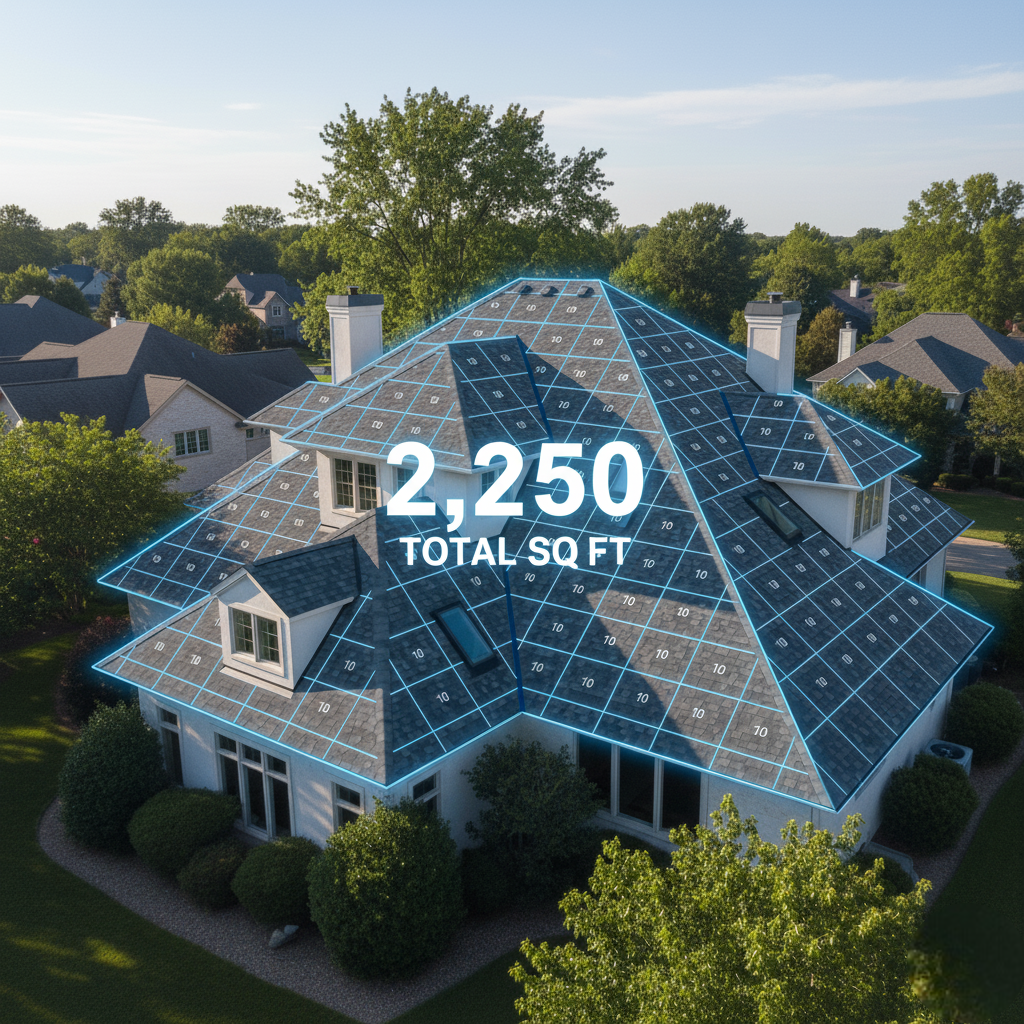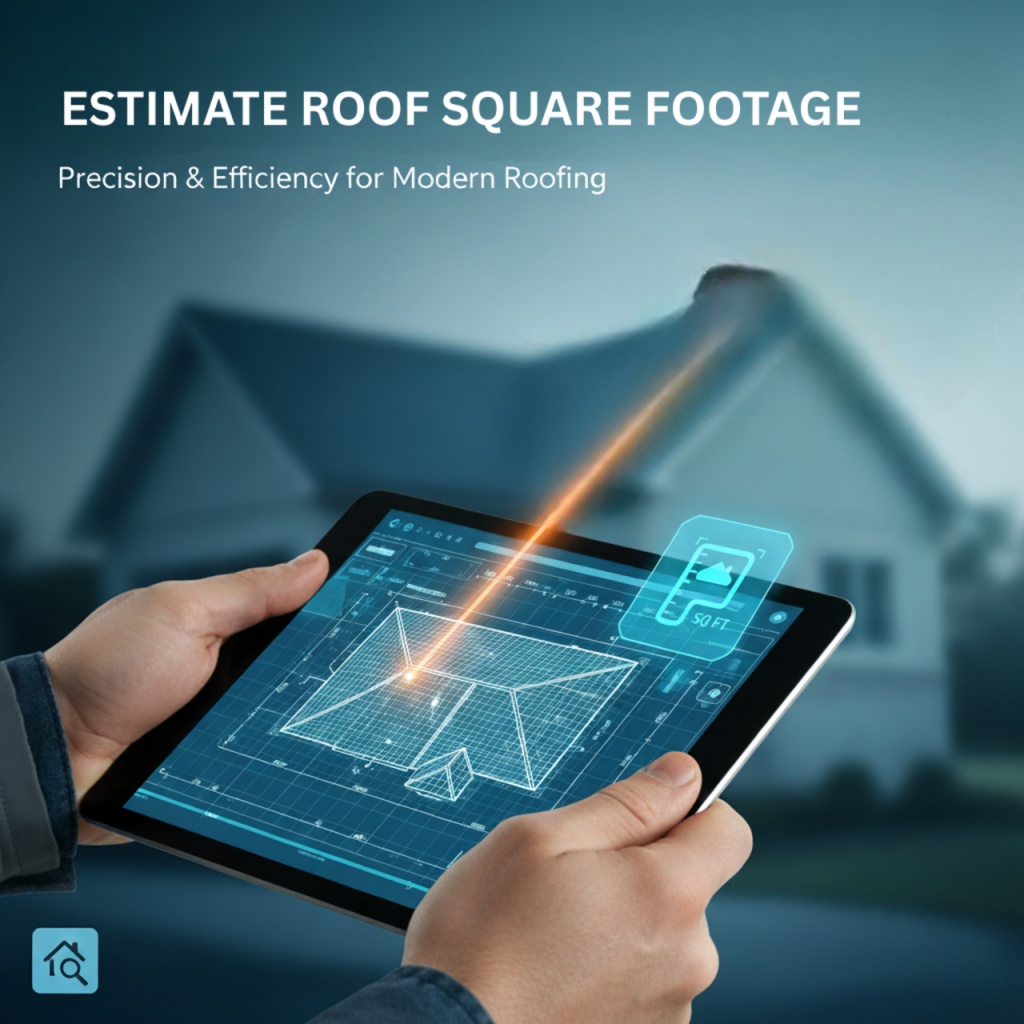Estimating roof square footage is a key component of any roofing project, so this is an important step, whether you are a roofing contractor, building owner, or estimator. Knowing how to measure roof area accurately is necessary to evaluate material, labor, and completion time fo r the project. This complete guide will tell you exactly how to determine roof square footage, including methods, tools, formulas, and the professionals’ tips to get accurate measurements.
Table of Contents
Understanding Roof Square Footage

Firstly, it is important to be clear on what roof square footage is referring to. Roof square footage is the surface area that needs roof material covering for type of structure (this includes slopes, hips, valleys, overhangs, etc.). Generally stated in “squares” (i.e., 1 roofing square = 100 sq. ft).
Example: 2,000 square foot roof = 20 squares.
Why Accurate Roof Measurements Matter
An inaccurate estimate may lead to a waste of materials, excessive expenditures, or a shortage during installation. This is the reason accurate roof measurement is important:
- Less waste: Ensures prudent material quantities.
- Prevents over-budget: Ensures material is purchased only when needed for the job.
- More efficiency: Assists contractors in their labor and logistics planning.
- Accurate quotes: Can demonstrate a level of trustworthiness to the client by avoiding surprises.
Tools You Need to Measure Roof Area
To accurately estimate roof square footage, you’ll need specific tools depending on your chosen method—manual, drone-based, or digital.
Traditional Tools
- Measuring tape or laser distance meter
- Roof pitch gauge
- Ladder and safety gear
- Calculator or measurement worksheet
Digital & Aerial Tools
- Aerial measurement software (like AerialEstimation.com)
- Satellite imagery tools
- CAD or 3D roof modeling tools
These tools help reduce errors and eliminate the need to climb roofs, making the process safer and more precise.
Step-by-Step Guide to Estimate Roof Square Footage
Step 1: Measure the Ground Dimensions
First, use either a measuring tape or a blueprint to measure the length and the width of your home at the ground level. This identifies the footprint of the building.
Example:
Length = 50 feet
Width = 30 feet
Ground area = 50 × 30 = 1,500 sq. ft.
Step 2: Determine the Roof Pitch
The pitch (slope) of a roof plays an essential role in determining the actual surface area of the roof. Roof pitch is shown as the rise over the run (for instance, a pitch of 6:12 means that for every 12 inches of run, there are 6 inches of rise on the roof).
You can measure roof pitch in three ways:
- A pitch gauge
- A level and tape measure
- Digital pitch finder apps
Roof Pitch Conversion Multiplier Table
| Roof Pitch | Multiplier |
|---|---|
| 3/12 | 1.03 |
| 4/12 | 1.05 |
| 5/12 | 1.08 |
| 6/12 | 1.12 |
| 7/12 | 1.16 |
| 8/12 | 1.20 |
| 9/12 | 1.25 |
| 10/12 | 1.30 |
| 11/12 | 1.36 |
| 12/12 | 1.41 |
Step 3: Apply the Roof Pitch Multiplier
Multiply your ground area by the roof pitch multiplier to calculate the total roof area. Multiply your ground area by the roof pitch multiplier to calculate the total roof area.
Example:
Ground area = 1,500 sq. ft.
Pitch = 6/12 (multiplier = 1.12)
Roof area = 1,500 × 1.12 = 1,680 sq. ft.
Step 4: Account for Roof Complexity
In the case that your home has several sections of the roof including gables, dormers, valleys, or hips, measure each area separately. Then, add up all the measurements to obtain the total roof square footage.
For roofs difficult to measure, considering utilizing drone imaging or aerial roof measurement reports for accuracy.
Step 5: Convert to Roofing Squares
Since roof materials are sold in squares, divide your total area by 100.
Example:
Roof area = 1,680 sq. ft.
1,680 ÷ 100 = 16.8 roofing squares
Bonus Tip: Include Waste Factor
Always include a waste factor to account for material trimming, overlaps, and fitting around structures like vents and chimneys.
| Roof Complexity | Recommended Waste % |
|---|---|
| Simple (gable) | 5% |
| Medium (hip) | 10% |
| Complex (valleys, dormers) | 15–20% |
Example:
Roof = 17 squares
Waste = 10% → 17 × 1.10 = 18.7 squares
Always order slightly more material than calculated to avoid shortages.
Alternative Methods to Measure Roof Area
Using Aerial Roof Measurement Reports
Current roofers utilise aerial roof measurement services like AerialEstimation.com, which utilise satellite imagery taken from the sky and AI technology to provide accurate roof measurements.
Benefits include:
- No need to climb on roofs
- Fast delivery (a few hours)
- Accurate 3D Modeling
- Time and money savings
Using Google Earth or Satellite Tools
You can also estimate the roof area using Google Earth or a mapping software that allows you to draw and directly measure roof outlines on the screen. The image resolution and whether the roof pitch was visible can create variable accuracy within this platform.
Calculating Roof Material Requirements
Once you know your total roof square footage, the next step is estimating how much material you’ll need.
Here’s a quick breakdown by roofing type:
| Roofing Material | Coverage per Square | Example Need (for 17 squares) |
|---|---|---|
| Asphalt Shingles | 100 sq. ft. | 17 bundles (3 per square = 51 bundles) |
| Metal Roofing | 100 sq. ft. | 17 sheets/panels |
| Clay Tiles | 100 sq. ft. | 17 tile sets |
| TPO/EPDM | 100 sq. ft. | 17 rolls |
Always verify with your supplier, as coverage may vary by brand and region.
Common Mistakes to Avoid When Measuring Roof Area
- Overlooking pitch of the roof: Measuring strictly flat dimensions results in under counting.
- Not accounting for waste: Will lead to shortage of materials halfway through the project.
- Not accounting for overhang: The edges of the roof increase square footage.
- Using non-recent maps or images: Will lead to inaccurate results digitally.
- Not regarding safety: Climbing on roofs is not safe without equipment—use a drone or aerial tools.
Professional Tip: Use Roof Measurement Services
If you want results that are precise and turn-key, a professional roof measurement report is the fastest and most accurate option. Companies like AerialEstimation.com deliver reports including:
- Total roof area including square feet and squares
- Roof pitch and slope information
- Length measurements for ridges, valleys, and hips
- Recommendations for waste factors
- 3d visual renderings
Having this information will help contractors quote jobs more promptly, eliminate the need for multiple site visits, and provide a higher bid accuracy—all a smart option for professionals across the USA and Canada.
Final Thoughts
Accurately assessing a roof’s square footage is essential to completing a roofing project. No matter if you are manually measuring or using aerial measurement software, accurate measurements save time, materials, and money. For contractors and homeowners, knowing how to do this eliminates headaches and leads to better roofing projects.
FAQs About Estimating Roof Square Footage
- Is there a way to measure my roof square footage without being on my roof?
You may look into aerial measurement tools, drone imaging, or services such as AerialEstimation.com. These services use satellite or drone data to provide an accurate measurement of your roof, so you do not have to get on it. - What is a roofing square, and how do I measure square footage for roofing squares?
A roofing square is 100 square feet of roof area. To determine how many roofing squares there are, simply divide your total roof square footage by 100.
Example: 1,800 sq. ft. (roof area) ÷ 100 (square footage to roofing square) = 18 roofing squares.
- How do I take into account roof pitch while measuring?
Roof pitch affects the total surface area of a roof. To obtain accurate square footage for a building with a roof, you can multiply your measured ground area by the pitch to consider slope in your dimensions. For example, if your roof pitch has a multiplier of 1.12 (for a 6/12 pitch), you would multiply your ground area by 1.12 to get the square footage for roofing. - How much extra roofing material should I order?
Always include a waste factor for trimming and fitting.
Simple roofs: 5% extra
Medium complexity: 10% extra
Complex roofs with dormers/valleys: 15-20% extra - What is the easiest and most accurate way to get roof measurements?
The easiest and most accurate option is to order an aerial roof measurement report. The report will provide you with accurate roof dimensional information, slope data, and material information packaged in a professional report that saves you time and improves the accuracy of your bid or repairs.


